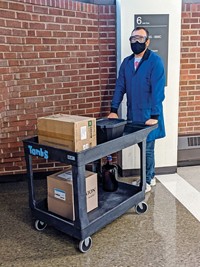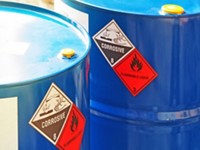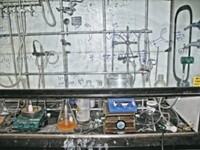Advertisement
Grab your lab coat. Let's get started
Welcome!
Welcome!
Create an account below to get 6 C&EN articles per month, receive newsletters and more - all free.
It seems this is your first time logging in online. Please enter the following information to continue.
As an ACS member you automatically get access to this site. All we need is few more details to create your reading experience.
Not you? Sign in with a different account.
Not you? Sign in with a different account.
ERROR 1
ERROR 1
ERROR 2
ERROR 2
ERROR 2
ERROR 2
ERROR 2
Password and Confirm password must match.
If you have an ACS member number, please enter it here so we can link this account to your membership. (optional)
ERROR 2
ACS values your privacy. By submitting your information, you are gaining access to C&EN and subscribing to our weekly newsletter. We use the information you provide to make your reading experience better, and we will never sell your data to third party members.
Policy
Campus Hazard
EPA finds waste violations at universities, works with schools to tailor rules aimed at industry
by CHERYL HOGUE, C&EN WASHINGTON
November 22, 2004
| A version of this story appeared in
Volume 82, Issue 47

Hazardous waste issues can crop up in all sorts of settings, not all of them industrial. Academic laboratories generate hazardous waste, too. At campuses large and small, chemistry, biology, and other labs may harbor poorly stored materials that can pose serious risks to students, professors, and staff.
The Environmental Protection Agency has found that some hazardous wastes at colleges and universities are best handled by a bomb squad.
For instance, Drew G. Meyer and another EPA inspector were alarmed during their 2003 inspection of Eastern Maine Community College, Bangor. There, in a storage room nestled between two student labs, they found about a half-dozen 1-L containers holding picric acid (2,4,6-trinitrophenol) waste that had crystallized.
Used as a reagent, picric acid is unstable and is highly explosive as a solid. The toxic chemical is highly sensitive to shock, heat, and friction.
Recognizing the danger the material posed, Meyer and his colleague closed off the area around the storage room, which Meyer says was not designed for safe and effective storage of hazardous waste.
The college responded by hiring a private hazardous waste disposal company, which detonated the picric acid on-site the day after the inspection. There were no injuries, and classes weren't disrupted because instruction had just finished for the semester, says Meyer, who works for EPA's New England regional office.
In the wake of the inspection, EPA last month fined the Maine Community College System more than $238,225 for allegedly violating federal hazardous waste regulations. This penalty would cover the problems at Eastern Maine Community College plus other alleged hazardous waste violations--such as failing to have proper labels on containers--at another school in the system, Southern Maine Technical College, Portland. The system did not respond to requests for comment.
FOR THEIR PART, some colleges and universities recognize they have had problems with handling their hazardous waste appropriately. However, academic institutions also note that federal hazardous waste laws were largely written for industrial situations, and the schools are working with EPA to alter those regulations to fit them better to the campus setting. In addition, EPA is reaching out to colleges and universities so they will perform self-inspections and correct any hazardous waste violations that turn up.
EPA has found that compliance with hazardous waste regulations isn't just a problem at small colleges and universities. Agency inspectors have discovered hazardous waste problems at big schools with reputations for technical sophistication. For instance, a 1998 EPA inspection at Massachusetts Institute of Technology found alleged violations of federal hazardous waste storage, handling, and labeling regulations in 56 of 114 laboratories inspected. The university has some 2,200 labs. EPA also cited MIT for environmental problems other than hazardous waste management.
"It is clear that the violations stem from institutional problems--too much decentralization of responsibility, lack of clear lines for environmental compliance, deficiencies in training programs, and lack of resources dedicated to environmental compliance," Ira Leighton, deputy regional administrator of EPA's Boston-based New England office, said in a 2001 statement. He noted that none of MIT's alleged violations caused actual environmental damage.
MIT settled the case in 2001 by paying a $150,000 fine, instituting an environmental management system for training on environmental regulations, and spending $405,000 on environmental projects. One of those projects is a "virtual campus" that lays out environmental regulatory requirements at a typical research university--including at laboratories, maintenance facilities, power plant, or art studios. This website, at http://www.c2e2.org/evc/home.html, serves as an in-house training tool for MIT as well an external one for other institutions. MIT did not respond to inquiries about this article.
In the past five years, EPA brought 145 cases against colleges and universities for alleged violations of federal hazardous waste rules, says an agency enforcement official who spoke to C&EN on the condition that she not be identified. During the same time, EPA filed 224 additional cases that included allegations that academic institutions failed to comply with hazardous waste regulations as well as rules governing water pollution, air pollution, handling and disposal of polychlorinated biphenyls, and right-to-know reporting. While these cases were filed across the U.S., most were concentrated in the Northeast and Pacific Southwest regions, the enforcement official says.
Sending EPA inspectors to academic institutions wasn't a priority set by the agency's Washington, D.C., headquarters, the enforcement official says. Instead, inspectors at three of the agency's 10 regional offices scattered throughout the U.S. began to identify colleges and universities as likely to have serious environmental compliance problems, she said. Those three offices are in areas of the U.S. that have a concentration of academic institutions--New England; a region encompassing New York, New Jersey, and Puerto Rico; and the Pacific Southwest office covering Arizona, California, Hawaii, Nevada, and tribal nations.
What EPA inspectors have found, she says, are not just paperwork violations, but problems, like crystallized picric acid, that pose a significant danger.
In some cases, chemicals that are reactive with each other are stored side by side on the same shelf, she continues. Inspectors often find such potentially dangerous situations when chemicals are shelved alphabetically, without regard to what materials are placed next to each other.
One of the largest enforcement cases involving hazardous waste problems at a school was at the University of Hawaii. In late 1997, EPA and the Hawaii Department of Health carried out inspections at the university. At the Manoa campus, inspectors found about 20 half-liter containers of picric acid in an unmarked cabinet at a storage area away from classrooms, says Robert Rodriguez, who was the lead EPA inspector for that official visit. That storage area "was a mess," Rodriguez tells C&EN.
But inspectors were even more concerned with a chemical storage room located in an old fallout shelter underneath the campus's main chemistry lecture hall, Rodriguez continues. That room was filled with hundreds of unmarked containers of chemicals, some open, some leaking, says Rodriguez, who is based in EPA's Pacific Southwest regional office in San Francisco. According to the Hawaii Department of Health, the university lacked a permit to store hazardous wastes in the academic building that housed this room.
A private contractor detonated the waste picric acid over the Christmas holiday, when students were away, Rodriguez says. The contractor also inventoried and disposed of the other waste chemicals, he says.
In December 2002, EPA and the Hawaii Department of Health settled alleged hazardous waste violations with the University of Hawaii. The university agreed to pay a $505,000 fine--80% of which went to the state, the remainder to the federal treasury--and to carry out $1.7 million in environmental improvement projects.
As part of the settlement, the university spent about half a million dollars to convert its undergraduate organic chemistry labs at the Manoa and Hilo campuses to microscale. This involves use of smaller amounts of chemicals and special small glassware. Microscale chemistry saves on chemical purchases and waste disposal.
Earlier this year, EPA and the Hawaii Department of Health announced that the switch to microscale experiments and implementation of the other environmental improvement projects have cut the university's waste generation and pollution by more than 13,000 lb per year. The university has also reduced the amount of chemicals it purchases and stores, cutting the potential for faculty, students, and staff to be exposed to hazardous materials.
"The projects that were developed and completed will serve as a foundation for future pollution prevention and waste minimization efforts at the university," Roy Takekawa, director of the Environmental Health & Safety Office at the University of Hawaii, said in an August statement.
EPA HAS REACHED out to universities and colleges across the country to help them comply with hazardous waste regulations, the agency enforcement official says. The agency is encouraging institutions of higher learning to do a self-check, called a compliance audit, to seek out any hazardous waste violations and correct them. If a college or university conducts an audit voluntarily, then discloses to EPA any problems found and how the institution has or is addressing those issues, the agency will reduce or eliminate any fines for violations. Generally, if the violations caused no environmental harm and the institution realized no economic gain from them, EPA will waive fines, the enforcement official explains.
Earlier this month, EPA announced the results of a massive audit effort by the University of California system. UC spent more than $1 million to check 47 facilities at nine campuses in Berkeley, Davis, Los Angeles, Irvine, Riverside, San Diego, San Francisco, Santa Cruz, and Santa Barbara.
UC reported about 100 violations of hazardous waste regulations, including storage without a permit and missing or unreadable labels, EPA says. Most of these violations were corrected during or shortly after the audit, the agency adds. EPA fined the university $9,750 for the violations, which is significantly lower than if agency inspectors had discovered the problems.
Johnny Torrez, director of facilities management and environmental protection services for the UC system, said in a Nov. 8 statement that the audit "was very helpful in evaluating our success and suggesting areas for increased attention." Torrez added, "As a result, we have redirected our resources to further improving compliance so that better control is achieved at each and every stage of the hazardous waste management process."
But refocusing efforts on compliance isn't a panacea for hazardous waste issues at universities and colleges. Institutions of higher learning say they find it difficult to apply hazardous waste regulations that were aimed at industry. The application of hazardous waste rules to colleges and universities has been an issue since EPA began issuing regulations under the 1976 Resource Conservation & Recovery Act (RCRA), says Bruce Backus, assistant vice chancellor for environmental health and safety at Washington University, St. Louis.
"Rules written for industry just don't fit very well with the lab setting" in academe, he tells C&EN. Many alleged hazardous waste violations at colleges and universities have involved paperwork--such as manifesting or labeling--and have not caused environmental harm, he adds. Academic institutions are spending so many resources on compliance with paperwork requirements that they have little or nothing left for proactive approaches, such as pollution prevention or environmental management systems, Backus says.
Another EPA official, who spoke to C&EN on the condition that she not be identified, says the agency recognizes that industrial hazardous waste regulations are not easily applied on campuses.
Backus chairs a panel of representatives from academic institutions working with EPA to tailor industrial hazardous waste regulations better to the campus setting. That group is the Colleges & Universities Sector Coordinating Committee. The panel is composed of the National Association of College & University Business Officers (NACUBO); the American Council on Education; the Association of Higher Education Facilities Officers; the Campus Consortium for Environmental Excellence; the Campus Safety, Health & Environmental Management Association; and the Howard Hughes Medical Institute. Michele Madia, a policy analyst at NACUBO, says her organization, composed of chief financial and chief administrative officers of colleges and universities, is involved because its members hold ultimate responsibility for their institutions' compliance with regulations.
Madia tells C&EN that the coalition offered draft regulatory language to EPA earlier this year that would make targeted changes to current RCRA rules that place a significant burden on colleges and universities. The agency is considering these recommendations and intends to propose regulatory changes in the future that will respond to academic institutions' concerns, according to the EPA official.
One of the committee's recommendations is to allow colleges and universities to determine whether a material is a hazardous waste when it arrives at central accumulation points or waste storage areas, Madia explains. Current regulations require a hazardous waste determination where the material is generated--which is often in chemistry or biology laboratories.
ANOTHER RECOMMENDATION is to allow institutions of higher learning to have 30 days, rather than three days, to move hazardous waste from academic labs to central accumulation areas, Madia continues. "This is particularly necessary during end-of-semester clean-outs," she says.
The extra time may allow those cleaning out a lab to redistribute chemicals or reagents that another lab can use--rather than chucking them all as hazardous waste to meet the three-day deadline, Backus says. In addition, large colleges and universities would prefer a regular hazardous waste pickup system rather than send crews sporadically across campuses to meet the three-day deadline for sending containers to a central accumulation area, he says.
Advertisement
Academic institutions also want to be able to deactivate some hazardous substances--either in the lab or at a central accumulation point--so the materials can then bypass the expensive hazardous waste treatment or disposal, Backus says. This could be as simple as adding water to crystallized picric acid or adding inhibitors to ethers that peroxidize, rendering them less sensitive to shock, he says.
The catch is this: EPA regulations currently require a hazardous waste storage, treatment, and disposal permit for deactivation. Colleges and universities want to do treatment without a permit.
In addition to revising the regulations, Backus says the academic sector group is concerned about the consistency of EPA's 10 regional offices in interpreting and enforcing RCRA regulations at colleges and universities. Also, because some states are delegated by EPA to enforce the federal hazardous waste law, academic institutions want those states to consistently interpret RCRA regulations, too, he adds.
Meanwhile, EPA inspectors say colleges and universities need to encourage their professors and researchers to do a better job of managing hazardous waste.
Rodriguez, who was an EPA inspector for nine years and is now an agency project manager for waste remediation at Superfund sites, says inspectors tend to find a disconnect between those who generate hazardous waste in academic laboratories and campus workers who manage that waste. Professors and researchers often don't follow hazardous waste regulations, he says, making it hard for their academic institutions to be in compliance.
"That's a common problem that we've found," he says, not only in the Pacific Southwest region where he is based but in other parts of the U.S. as well.
Meyer, the inspector for EPA's New England regional office, says many colleges and universities fail to train students and faculty on the proper ways to handle hazardous waste. And some faculty members aren't interested in such training, he adds.
"They tend to be autonomous," working within their own labs, Meyer tells C&EN. "They're very cavalier about managing chemicals," he says, if they've been working around chemicals for years.








Join the conversation
Contact the reporter
Submit a Letter to the Editor for publication
Engage with us on Twitter